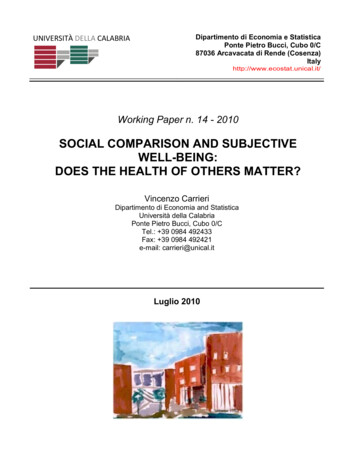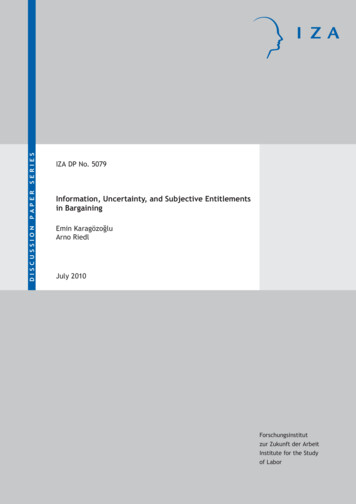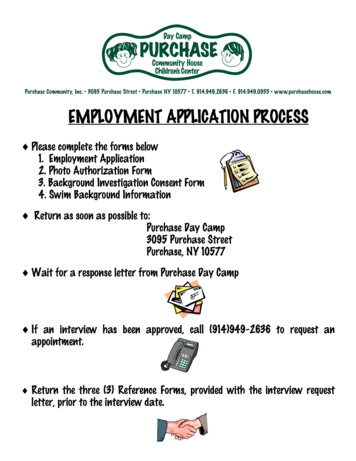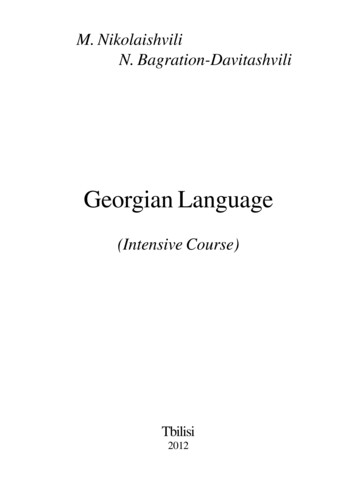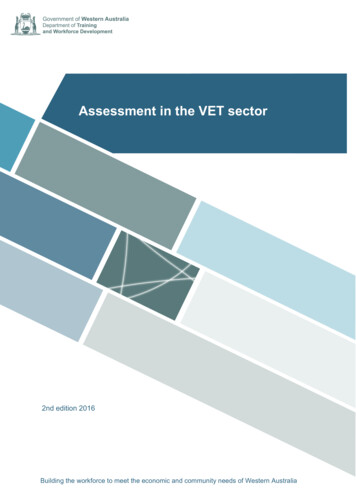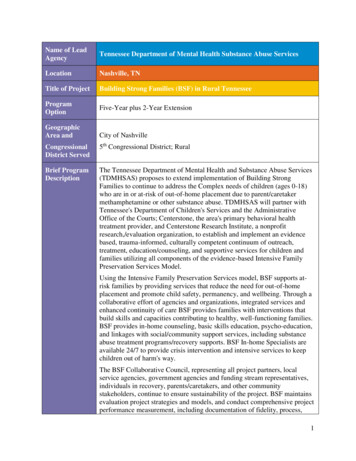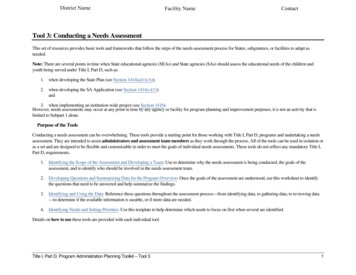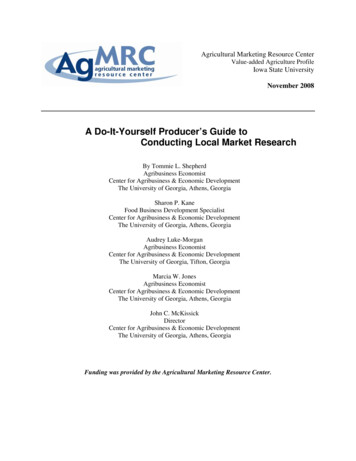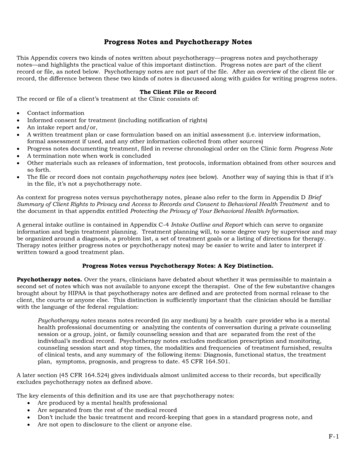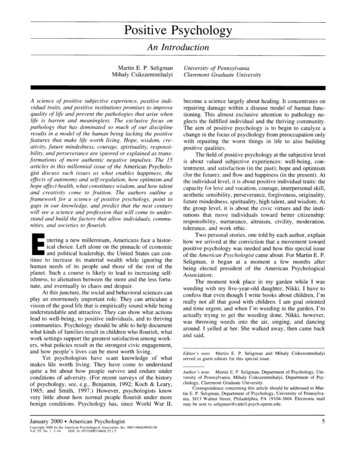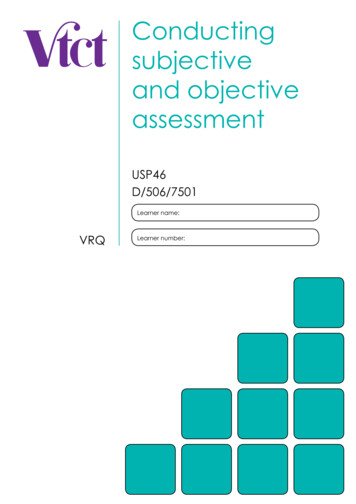
Transcription
Conductingsubjectiveand objectiveassessmentUSP46D/506/7501Learner name:VRQLearner number:
VTCT is the specialist awarding organisation for the Hairdressing, Beauty Therapy,Complementary Therapy, Hospitality and Catering and Sport and Active Leisure sectors, withover 50 years of experience.VTCT is an awarding body regulated by national organisations including Ofqual, SQA, DfES andCCEA.VTCT is a registered charity investing in education and skills but also giving to good causes inthe area of facial disfigurement.Statement of unit achievementBy signing this statement of unit achievement you are confirming that all learning outcomes, assessmentcriteria and range statements have been achieved under specified conditions and that the evidencegathered is authentic.This statement of unit achievement table must be completed prior to claiming certification.Unit codeDate achievedLearner signatureAssessorinitialsIV signature(if sampled)Assessor tracking tableAll assessors using this Record of Assessment book must complete this table. This is required forverification purposes.Assessor nameAssessor signatureAssessorsinitialsAssessor number(optional)
USP46Conducting subjective andobjective assessmentThe aim of this unit is to develop the skills, knowledge andunderstanding needed to analyse information gatheredfrom subjective and objective client assessments. Youwill also develop detailed knowledge of the bony and softstructures of the major joints of the body, factors that maypredispose clients to injury, factors that may influenceclients ability to recover from injury, postural deviations,ageing and the pathophysiology of common muscle andtendon injuries.You will be taught a variety of objective testing methods,to include: range of movement (active, passive andresisted), postural analysis and a range of functional andspecial tests. This will include interpretation of the findingsand ability to evaluate each method critically. Ultimately,from the information gathered, you will be able to deviseappropriate treatment plans supported with rationale forchoices.USP46 v1
Level4Credit value7GLH50Observation(s)5External paper(s)0
Conducting subjective andobjective assessmentYou need to meet the same standard on aregular and consistent basis. Separatingthe assessments by a period of at least twoweeks is recommended as competencemust be demonstrated on a consistent andregular basis.Learning outcomesOn completion of this unit you will:1.Be able to conduct subjective and objectiveassessment2.Be able to devise a sport massagetreatment plan3.Understand the anatomy and physiology ofthe major joints of the body4.Understand the influences and effects ofclient information on treatment planning5.Understand the effects of anatomy,physiology and pathology on humanfunction6.Understand the principles and practice ofobjective assessment techniques4.RangeAll ranges must be practicallydemonstrated.5.Knowledge outcomesThere must be evidence that you possessall the knowledge and understandinglisted in the Knowledge section of thisunit. In most cases this can be doneby professional discussion and/or oralquestioning. Other methods, such asprojects, assignments and/or reflectiveaccounts may also be used.6.Tutor/Assessor guidanceYour tutor/assessor must adhere to the‘Assessment Guidance and EvidenceRequirements’ for this unit. This can befound under documents on the relevantqualification page at www.vtct.org.uk.Evidence requirements1.EnvironmentEvidence for this unit may be gatheredwithin the workplace or realistic workingenvironment (RWE).2.SimulationSimulation is not allowed in this unit.3.Observation outcomesCompetent performance of Observationoutcomes must be demonstrated onat least five occasions. Assessorobservations, witness testimonies andproducts of work are likely to be the mostappropriate sources of performanceevidence. Professional discussion may beused as supplementary evidence for thosecriteria that do not naturally occur.You will be guided by your tutor/assessoron how to achieve learning outcomes andranges in this unit. All outcomes and rangesmust be achieved.7.External paperThere is no external paper requirement forthis unit.USP463
Achieving observationsand rangeAchieving observation outcomesYour assessor will observe your performanceof practical tasks. The minimum number ofcompetent observations required is indicated inthe Evidence requirements section of this unit.Criteria may not always naturally occur duringa practical observation. In such instances youwill be asked questions to demonstrate yourcompetence in this area. Your assessor willdocument the criteria that have been achievedthrough professional discussion and/or oralquestioning. This evidence will be recordedby your assessor in written form or by otherappropriate means.Your assessor will sign off a learning outcomewhen all criteria have been competentlyachieved.Tutor/assessor guidanceYour tutor/assessor must adhere to the‘Assessment Guidance and EvidenceRequirements’ for this unit. This documentwill give guidance for the tutor/assessor onbreadth and depth of content that must becovered in this unit. This can be found underthe documents tab on the relevant qualificationpage at www.vtct.org.uk.4USP46Achieving rangeThe range section indicates what mustbe covered. Ranges should be practicallydemonstrated as part of an observation.Your assessor will document the portfolioreference once a range has been competentlyachieved.
ObservationsLearning outcome 1Be able to conduct subjective and objective assessmentYou can:a.Carry out subjective assessments of clientsb.Obtain consent for objective assessmentsc.Carry out objective assessments of clientsd.Record client information in accordancewith professional practice requirementse.Store clients’ information as legally required*May be assessed by supplementary evidence.Observation12345OptionalDate achievedCriteria questioned orallyPortfolio referenceAssessor initialsLearner signatureObservationDate achievedCriteria questioned orallyPortfolio referenceAssessor initialsLearner signatureUSP465
Learning outcome 2Be able to devise a sport massage treatment planYou can:a.Devise treatment planb.Explain rationale for chosen massageinterventionsc.Present massage interventions andrationale to clientsd.Obtain consent for treatment*May be assessed by supplementary evidence.Observation12345OptionalDate achievedCriteria questioned orallyPortfolio referenceAssessor initialsLearner signatureObservationDate achievedCriteria questioned orallyPortfolio referenceAssessor initialsLearner signature6USP46
Range*You must practically demonstrate that you have:Carried out objective testing on all major jointsPortfolio referenceAnkle and footKneeHipShoulderElbowWrist/handSpineIdentified all structures of major jointsPortfolio referenceSoft structuresBony landmarksJoint end feelUSP467
Developing knowledgeAchieving knowledge outcomesYou will be guided by your tutor and assessoron the evidence that needs to be produced.Your knowledge and understanding will beassessed using the assessment methods listedbelow*: ProjectsObserved workWitness statementsAudio-visual mediaEvidence of prior learning or attainmentWritten questionsOral questionsAssignmentsCase studiesProfessional discussionWhere applicable your assessor will integrateknowledge outcomes into practical observationsthrough professional discussion and/or oralquestioning.When a criterion has been orally questionedand achieved, your assessor will record thisevidence in written form or by other appropriatemeans. There is no need for you to produceadditional evidence as this criterion has alreadybeen achieved.Some knowledge and understanding outcomesmay require you to show that you know andunderstand how to do something. If you havepractical evidence from your own work thatmeets knowledge criteria, then there is norequirement for you to be questioned again onthe same topic.*This is not an exhaustive list.8USP46
KnowledgeLearning outcome 3Understand the anatomy and physiology of the major joints ofthe bodyYou can:a.Identify bony structures associated with the major jointsb.Explain the functions of bony structures associated with the majorjointsc.Identify soft tissue structures located at the major jointsd.Explain the function of soft tissue structures located at the majorjointse.Explain the different types of joint-end feelPortfolio referenceUSP469
Learning outcome 4Understand the influences and effects of client information ontreatment planningYou can:10a.Explain factors which may predispose clients to injury anddysfunctionb.Explain how factors may influence a client’s ability to recover frominjuryc.Give examples of how subjective information may influencetreatment planningd.Identify reasons for treatment deferral and referralUSP46Portfolio reference
Learning outcome 5Understand the effects of anatomy, physiology and pathologyon human functionYou can:a.Describe the characteristics of common postural typesb.Explain the effects of postural deviationsc.Describe the pathophysiology of common injuries/soft tissuedysfunctiond.Explain how the ageing process affects the musculo-skeletalsystemsPortfolio referenceUSP4611
Learning outcome 6Understand the principles and practice of objectiveassessment techniquesYou can:12a.Explain the methods and purpose for a range of objectiveassessment techniques: asymmetry palpation range of movement (Active, Passive, Resisted) postural analysis functional tests special testsb.Explain how to interpret findings for each objective assessmenttechniquec.Critically evaluate the range of objective assessment methodsused to gather informationUSP46Portfolio reference
Unit contentThis section provides guidance on the recommended knowledge and skills required to enable youto achieve each of the learning outcomes in this unit. Your tutor/assessor will ensure you have theopportunity to cover all of the unit content.Learning outcome 1: Be able to conduct subjective and objectiveassessmentCarry out subjective assessment: Ageand occupation, sport and leisure activities,previous medical history, previous injuries,medication, other lifestyle factors (stress,diet, dependants), aims and objectivesof treatment, perceived problem, siteand spread of symptoms, behaviourof symptoms, onset and duration ofsymptoms, pain scale, aggravating andrelieving factors.Record information: SOAP format, inaccordance with requirements (legal,professional practice).Store information: As legally required.Obtain consent for objectiveassessment: Verbal, written, prior to andduring assessment, practitioner explainsnature and purpose of assessment, risks,alternatives, effects.Carry out objective assessments:Asymmetry, palpation, range of movement– active, passive, resisted, posturalanalysis, functional tests, special tests.Learning outcome 2: Be able to devise a sport massage treatment planDevise treatment plan: From subjectiveand objective information gathered, meetclient objectives.Explain rationale: Verbal to client, forchosen massage interventions.Present massage interventions andrationale to clients: Present verbally toclients.Obtain consent: Verbal, written(signature), prior, ongoing.USP4613
Learning outcome 3: Understand the anatomy and physiology of the majorjoints of the bodyIdentify bony structures: Palpation ofbony structures, palpation of overlyingstructure where not possible to directlypalpate.Spine/head/Thorax – joint line (posteriorsacroiliac joint), landmarks (Spinousprocess of C7, T3, T7, L4, sacrum, occipitalprocess, mastoid process).Ankle and foot – joint line (talocrural,subtalar), landmarks (medial/lateralmalleolus, peroneal tubercle, naviculartuberosity, talar dome, tarsals, metatarsals,phalanges).Functions of bony structures:Attachments for ligaments, origin andinsertion for muscles, location identifier.Knee – joint line (tibiofemoral (lateraland medial)), landmarks (superior pole ofpatella, inferior pole of patella, lateral andmedial femoral condyle, tibial tuberosity,lateral and medial femoral epicondyle,head of fibula, adductor tubercle, pesanserine, lateral and medial tibialepicondyle).Hip – joint line (femoroacetabular,sacroiliac), landmarks (iliac crest, anteriorsuperior iliac spine, anterior inferior iliacspine, posterior superior iliac spine,ischial tuberosity, pubic tubercles, greatertrochanter).Shoulder – joint line (glenohumeral,acromioclavicular, sternoclavicular),landmarks (acromion process, coracoidprocess, greater tubercle, lesser tubercle,lateral/medial border of scapula, inferior/superior angle of scapula, spine of scapula,clavicle).Elbow – joint line (radioulnar, humeroulnar,humeroradial), landmarks (lateral andmedial epicondyle, head of radius,olecranon process).Wrist/hand – joint line (radiocarpal,ulnocarpal), landmarks (radial and ulnarstyloid processes, carpals, metacarpals,phalanges).14USP46Identify soft tissue structures:Attachments for ligaments, origin andinsertion for muscles, location identifier.Ankle and foot: Anterior and posteriortalofibular ligament, calcaneofibularligament, Achilles tendon, deltoid ligament,plantar fascia, short and long plantarligament, spring ligament, retinaculum(anterior, lateral. posterior), deep andsuperficial Achilles bursa, interosseousmembrane, retinaculum.Knee: Lateral collateral ligament, medialcollateral ligament, patellar tendon, medialand lateral meniscus, bursa- (pes anserine,prepatellar, suprapatellar, superficialinfrapatellar).Hip: Inguinal ligament, superficial anddeep trochanteric bursa, ischial bursa,ischiofemoral, iliofemoral, pubofemoralligaments, labrum, sciatic and femoralnerve.Shoulder: Acromioclavicular ligament,coracoclavicular ligament, coracoacromialligament, sternoclavicular ligament,interclavicular ligament, glenohumeralligaments, coracohumeral ligament,transverse humeral ligament, subacromialbursa, bicep tendon, labrum, brachialplexus pathway.Elbow: Lateral and medial collateralligaments, annular ligament, olecranonbursa, interosseous membrane.
Learning outcome 3: Understand the anatomy and physiology of the majorjoints of the body (continued)Wrist and hand: Radiocarpal andulnocarpal collateral ligaments, flexorretinaculum, interosseous membrane,carpal tunnel, (tunnel of Guyon), ulnar,median and radial nerve.Spine/head: Posterior sacroiliac ligaments,sacrospinous ligament, sacrotuberousligament, iliolumbar ligament, supraspinousligament, ligamentum nuchae, sciaticnerve, knowledge of sacral/lumbar plexus.(releases synovial fluid to lubricate joint,supplies nutrients to avascular cartilage).Different types of end feel: Normal - hard(bony), soft (soft apposition), firm (softtissue stretch), capsular, abnormal, hard,soft, firm, springy, spasm, empty.Function of soft tissue structures:Tendons (connect muscle to bone),ligaments (connect bone to bone), bursa(reduces friction between tendons andbones, dissipates force), fascia (reducesfrictions between muscles, keeps organsin cavities, provides a flexible covering fornerves and blood vessels as they passthrough other tissue), synovial membranesLearning outcome 4: Understand the influences and effects of clientinformation on treatment planningFactors which may predispose clientsto injury and dysfunction: Lifestyle, age,diet, previous injury, levels of activity, typeof training, levels of fitness appropriateto activity, stress, rest, gender, bodycomposition, imbalances, anatomy, health,how factors can influence.Factors influencing recovery frominjury: Fitness levels, health, psychosocial,psychosomatic.Subjective information and influenceon planning: Psychological, severity,irritability, acute/chronic, red and yellowflags, contra-indications, to informtreatment plan, needs of client andpreferences, pre-existing conditions,medical history, previous treatment, currenttreatment objective, results of tests.Reasons for deferral and referral:Contra-indications, contra-actions, red andyellow flags, acute inflammation, fractures/breaks (anything that’s not muscularor tendon soft tissue damage), referralif treatment is not working, results areunpredictable, beyond scope of practice,best interests of client.USP4615
Learning outcome 5: Understand the effects of anatomy, physiology andpathology on human functionCommon postural types: Centre ofgravity (lateral), upper and lower crosssyndrome, scoliosis, hyper and hypolordosis, hyper and hypo kyphosis, swayback, neutral spine, military, slumped, flatback, dowagers hump, posterior, anterior,lateral pelvic tilt and rotations, sportsspecific postures.Characteristics: Shortening or lengtheningof associated muscles, pain in affectedareas e.g. neck, lumbar, hips, knees,headaches, poor circulation, muscleimbalances, reduced mobility and function,antalgic gait, physical deformity.Effects of postural deviations:Compensatory somatic patterns,physiological effects, psychological effects,effects on performance (negative/positive),increased susceptibility to injury.Common injuries/soft tissuedysfunction: Muscle strains, spasms,cramps, tendinopathy/tenosynovitis,compartment syndrome (most commonleg or forearm), inter/Intra muscularhaematoma, common signs - cardinalsigns (redness, heat, swelling, pain, lack offunction), bleeding, deformity.Pathophysiology:Ankle/foot – achilles rupture, fibularfracture, anterior capsule, calcanealbursitis, plantar fasciitis, ATFL sprain.Leg – shin splints, tibial stress fracture.Knee – effusion, runners knee, pesanserine bursitis, Osgood Schlattersdisease, patella bursitis (pre, supra, infra),imbalance VMO and vastus lateralis,jumpers knee (patella tendinopathy).Hip – hip stability, gluteus mediusweakness, hip flexor tightness/contracture,16USP46rectus femoris tightness, leg length (trueand apparent), ITB length, piriformissyndrome, trochanteric bursitis, myositisossificans.Shoulder – rotator cuff (impingement,tendinitis, strain), subacromial bursitis/impingement, subacromial impingement,supraspinatus strain, long thoracic nervedamage, weak serratus anterior/midtrapezius, scapula winging, bicep tendontendonitis, biceps tendonitis, claviclefracture.Elbow – medial epicondylitis, lateralepicondylitis, olecranon bursitis.Wrist and hand – fractures, radial andulnar arteries, scaphoid fracture, navicularfracture, carpel tunnel syndrome, flexortenosynovitis, flexor tendon avulsion,extensor tendon avulsion, De Quervain’sdisease, median, ulnar or radial nerve.Back and neck – sciatica check (lumbaror piriformis syndrome), vertebral fracture,herniated disc, facet joint lock, facet jointsyndrome, pain cord compression, spinalcord or nerve root damage, rib fracture.Aging process: Sarcopenia, bone densitydecreases, vertebral disks degenerate,loss of cartilage, decrease in elasticityof tendons and ligaments, decrease inamount and quality of collagen.Effect on musculo-skeletal systems:Loss of muscle mass, loss of strength,osteoporosis, osteophytes, loss of height,postural changes, arthritis, reduced mobilityand function, involuntary movement(fasciculations).
Learning outcome 6: Understand the principles and practice of objectiveassessment techniquesAsymmetry (methods): Visualobservation, postural grid, apps,photography, anterior, posterior and lateralview, comparison to contralateral side,distance from mid-line, unequal levels,measurement from bony landmarks.Asymmetry (purpose): Muscle imbalance,skeletal fault, joint malfunction, determinecentre of gravity, identify over or underdeveloped muscles, provide baselineassessment.Palpation (methods): Superficial, deep,applicator (pads of fingers, thumbs, palms,back of hand), performed systematicallyand bilaterally, work from outer towardsarea of discomfort, superficial to deeperpressure, observe facial expression.Palpation (purpose): Detect heat,oedema, assess texture of tissue, locatebony landmarks, assess muscle tone,assess tenderness/pain, locate deformity,detect pathology, assess myofascia.Range of movement (methods):Active – goniometer measurement indegrees, visual observation, measurepatient carries out movement, stabiliseunwanted movement, compare tocontralateral limb, good limb first.Passive – therapist moves joint throughplanes of movement normal to joint,assessment stops should pain occur,overpressure at end of range to assess forjoint end feel, comparison to contralaterallimb.Resisted – resistance applied by therapistto cause an isometric contraction of musclebeing tested, muscle tested mid range,pressure applied at distal part of limb, slowsmooth application of pressure, stabilisejoint above, ensure recruitment of musclebeing tested only, hold 10-20 seconds,Cyriax scale, Oxford scale, comparison tocontralateral limb.Range of movement (purpose):Active – assess limitations in ROM,quality/ease of movement, patientswillingness to move joint, determine pointof onset of pain, identify crepitus, providesbaseline measurement.Passive – identify hypo or hypermobility,provide information about joint capsule,ligaments and muscle tone.Resisted – test muscle strength, providesbaseline measurement.Postural analysis (methods): Visualobservation, plumb line, apps, posturalgrid, goniometer, photography, anterior,posterior and lateral views, spinalalignment and curves, trunk rotation.Postural analysis (purpose): Muscleimbalance, skeletal fault, joint malfunction,determine centre of gravity, identify over orunder developed muscles, provide baselineassessment.Functional tests (methods):Sit to stand – regular height chair with noarms, patient arms across chest, sit andstand five times, back does not touch rearof chair, one trial.Walking – treadmill or floor, use of video,use of apps, bare feet, legs visible, patientwalks forward, observe from all directions.Squat – bare feet, legs visible, feet hipwidth apart, squat so thighs are parallel tofloor, patient lifts and lowers repetitively,use of video or apps.USP4617
Learning outcome 6: Understand the principles and practice of objectiveassessment techniques (continued)Lunge – bare feet, legs visible, patienttakes long stride forward, lowers back kneeto ground, 90 knee and hip angle for bothlegs, push back, repeat with opposite leg.Functional tests (purpose):Sit to stand – assess for muscleweakness, lack of balance, lack of coordination, fatigue.Walking – assess for antalgic gait, poorfoot biomechanics, abnormal gait cycle,biomechanical abnormalities, pathology ofankles, knees, hips, uneven stride widthand length.Squat – identify muscle imbalance, poorco-ordination, hypo or hypermobility, hyperor hypotonic muscles.Lunge – identify muscle imbalance, poorco-ordination, hypo or hypermobility, hyperor hypotonic muscles.Special Tests (methods):Ankle – bump test (percussion test),Thompson squeeze or Flipper Test, calflength test.Knee – patella tap, sweep (effusion),patella maltracking (lateral pull test),modified Ober’s test, Noble’s test.Hip – Trendelenburg, Thomas Test, KendallTest, leg length (true and apparent),modified Ober’s Test, piriformis length test.Shoulder – arm drop test, painful arctest, empty can test, Apley’s scratch test,Speed’s test, active impingement test(Neer’s test), impingement relief test,Gerber’s lift off sign, Hawkins Kennedytest.Elbow – Mill’s test, Cozen’s sign, passivetest (medial epicondylitis).18USP46Wrist and hand – metacarpal and carpalpercussion, scaphoid load test, triggerfinger test, Jersey finger sign, mallet fingertest, Finkelstein test, Phalen’s test, reversePhalen’s test.Back conditions – the straight leg raiseand/or slump.Purpose: Assess muscle length or tone,possible injury, muscular imbalance,impingement, muscle weakness, bonepathology.
Be able to devise a sport massage treatment plan 3. Understand the anatomy and physiology of the major joints of the body 4. Understand the influences and effects of client information on treatment planning 5. Understand the effects of anatomy, physiology and pathology on human function 6. Understand the principles and practice of
